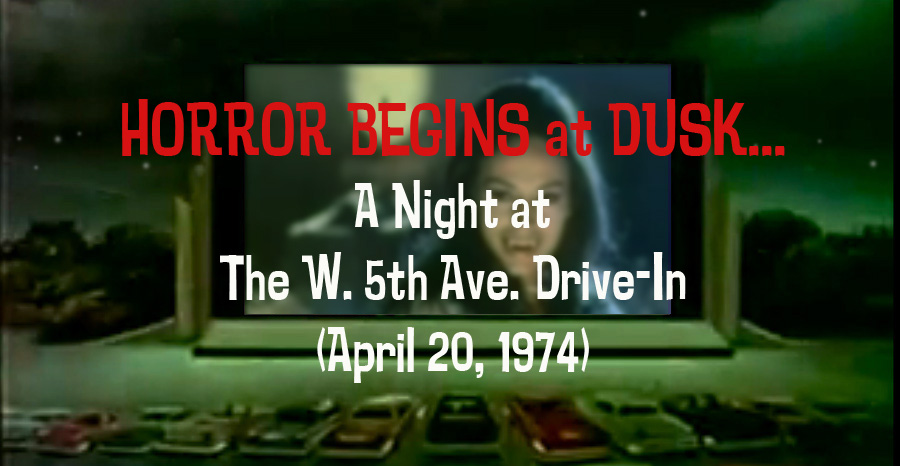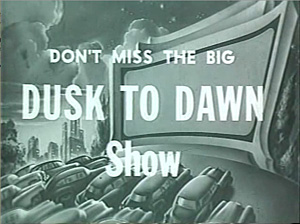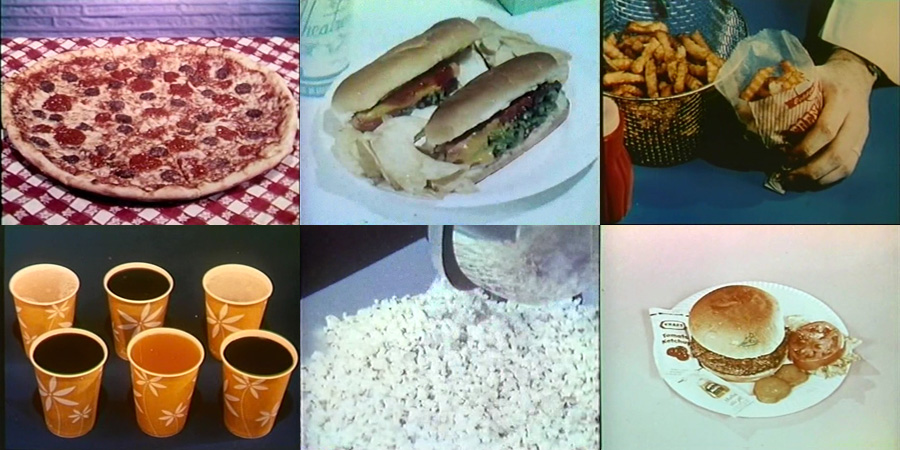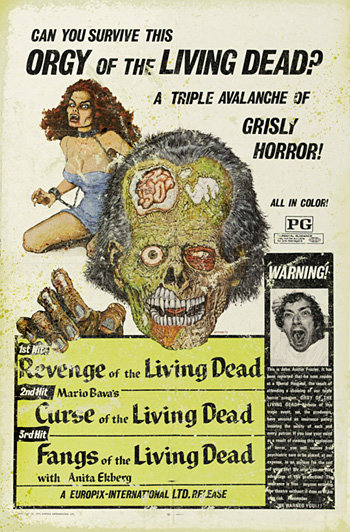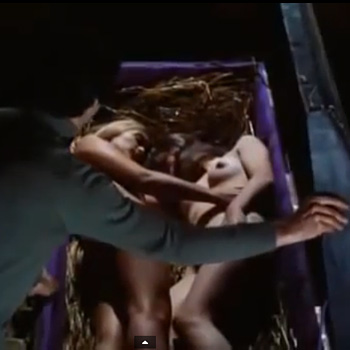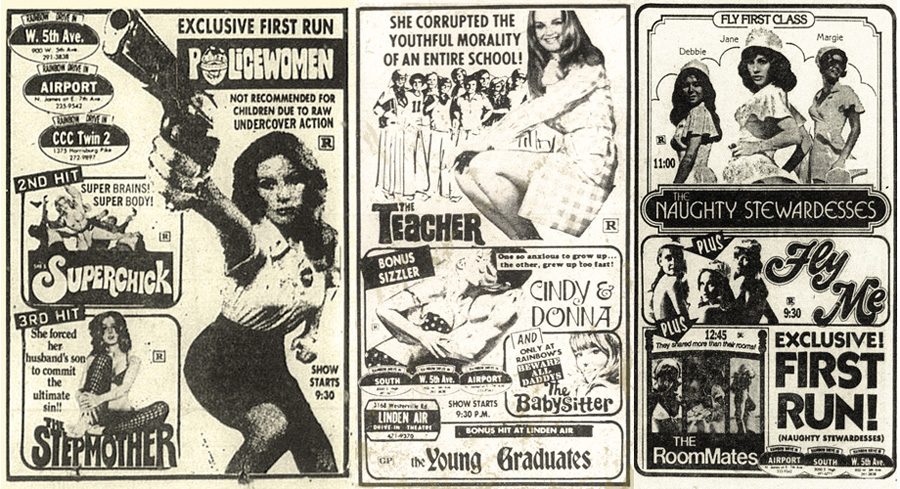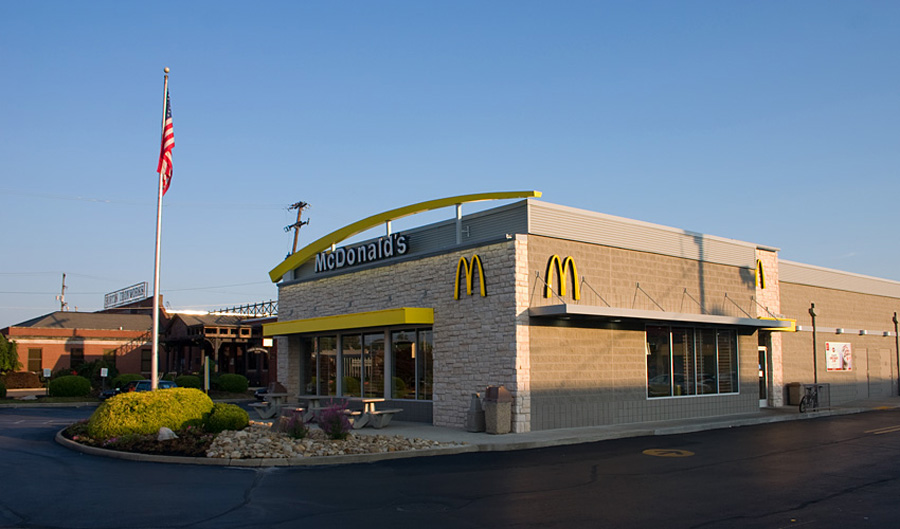|
|||
|
The University District was once served by a drive-in theater less than 10 minutes away from 15th and High. The West 5th Ave. Drive-In at 900 W. 5th Ave. entertained Near Northside audiences for a quarter-century from 1953 to 1978. The W. 5th was an unusual drive-in. It was urban instead of rural. As a rule, drive-ins were located on cheap land close to a highway at the fringes of a city, outside city limits and away from city taxes and regulation. Not the W. 5th. The W. 5th Ave was in the middle of an industrial and commercial district, surrounded by city on all sides. The drive-in was squeezed into a narrow lot between the Columbus Showcase factory, Exact Weight and Scale, and several other industrial buildings. A used car lot occupied most of the theater's 5th Ave street frontage. |
||
The W. 5th Ave was small compared to other drive-ins. It was only about 5 acres and held around 250 cars. By comparison, the Linden Air (1950-80?), up on Cleveland Ave. and the still extant South Drive-In (1950- ) on S. High are both 14 acres with capacity for over 500 cars. The layout of the old W. 5th was also odd. Most drive-ins are fan-shaped. The W. 5th was rectangular. Most drive-ins located their screen at the narrow part of the fan, the W. 5th put its screen in one of the corners of the rectangle. It was odd but audiences didn't seem to mind. Despite being urban, small, and oddly laid-out, the W. 5th was a normal drive-in in every other way. Throughout the 1950s, the theater served up a steady diet of low budget genre films--war pictures, tons of Westerns, kid’s movies, and the schlocky horror and sci fi of the era. In the early 60s, teensploitation pictures, like the Frankie Avalon-Annette Funicello beach movies, found their natural home at the drive-in. Second-run Hollywood pictures would leaven the mix. The big Hollywood studios didn’t like drive-ins and were reluctant to place their big pictures there. In the 1970s, drive-ins began venturing down the route pioneered by dying urban neighborhood theaters. The drive-ins began showing controversial, violent, gory, and nudity and sex-filled pictures that audiences couldn’t see on TV and the family-friendly suburban mall cinemas wouldn’t touch. Bikersploitation, blaxploitation, hixploitation, sexploitation, and horror movies flourished. American International Pictures, Roger Corman’s New World Pictures, and dozens of lesser producers kept the drive-in screens filled.
Saturday, April 20, 1974 was a warm, sunny, spring day. It wasn't summer yet but the afternoon's 74° high had everybody thinking it wasn't far off. The boys roared into the drive-in in gas-guzzling Ford Mustangs, Chevy Impalas and Novas, and unsightly Ford Pintos, Dodge Darts, and the occasional AMC Gremlin. In the back row there might have been a custom van or two, converted into a make-out pad/dope den on wheels with floor-to-ceiling shag carpet, mirror tiles on the ceiling, and maybe even a waterbed. No pick-ups. Only farmers, loggers, and construction workers drove trucks back then. The audience was mostly teens and young adults but not entirely. Drive-ins were popular with families who didn't have to worry about a babysitter for the kids. The nearby neighborhoods that have since become the Short North, Victorian Village, Harrison West, and Fifth by Northwest were lower-middle-class neighborhoods in the Seventies, full of budget-conscious, blue-collar families with children. The radios, tuned to 92.3 WCOL-FM, would have been blaring "Bennie and the Jets" by Elton John (#1 on the charts), The Jackson 5's "Dancing Machine," Redbone's "Come and Get Your Love," and Maria Muldaur's "Midnight at the Oasis." It being The Seventies--oddball, novelties like Ray Stevens' "The Streak" and Sister Janet Mead's "The Lord's Prayer" were also Top 20 hits. If anybody had been listening to the news, the stories would have told of the continuing clean-up in Xenia, Ohio after a F5 tornado nearly erased it on April 3, the on-going Watergate investigations and collapse of the Nixon presidency, war in the Middle East, and economic stagnation and high inflation at home. In the past year, the price of gas had doubled to 65¢ a gallon! |
|||
On the bill at the W. 5th Ave. that Saturday in 1974 was a dusk-til-dawn horror show. Movies started just after the sun went down and kept going until it rose again the next morning. |
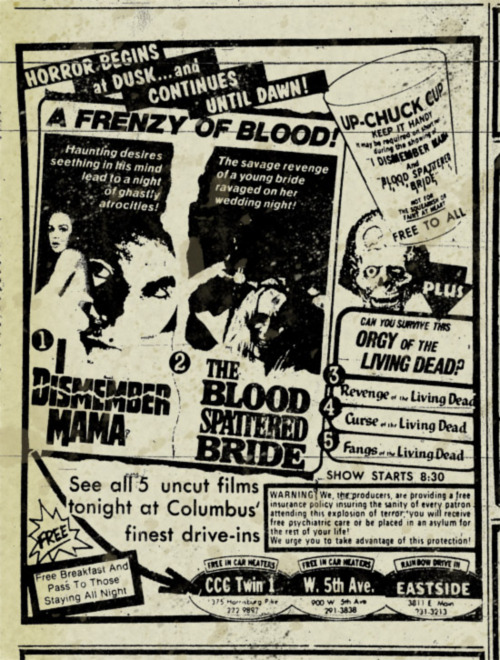 |
||||
|
|||||
Back in The Seventies, drive-ins showed drive-in movies--not what drive-in movie critic Joe Bob Briggs called “indoor bullstuff.” Blood, breasts, and beasts were the hallmarks of a good drive-in picture. Saturday's pictures were certainly drive-in movies. All five were cheaply-made, lurid, blood-drenched horror films about murdering psychopaths, lesbian vampires, and vengeful ghosts that featured ample violence, gore, sex, and nudity: |
|||||
|
I Dismember Mama (USA, 1974)- A psychopath escapes from a mental institution, intent on murdering his mother, and slaughters many people along the way before he meets an unexpectedly resourceful foe in a maid’s young daughter. Blood-Splattered Bride (Spain, 1972)- A young bride on her honeymoon finds her new husband to be less than she hoped for. She takes comfort in the arms of a mysterious woman and falls under the spell of a seductive vampiress. Loosely based on Sheridan Le Fanu’s Carmilla. Revenge of the Living Dead (Italy, 1966)- A hooded murderer with a razor stalks the corridors of a strange clinic with many secrets to hide. Curse of the Living Dead (Italy, 1966)- A visiting doctor must fight the hate-mad ghost of a little girl to prevent the slaughter of the residents of a remote Carpathian village. Considered one of the best of legendary Italian horror director Maro Bava’s films. Fangs of the Living Dead (Italy-Spain, 1969)- A fashion model inherits the family castle and travels there to find it full of strange relatives who turn out to be vampires. By celebrated Spanish horror director Amando de Ossorio. |
||||
Those were also the golden days of ballyhoo. They drive-ins didn’t just show movies, they sold them. The theater wanted patrons to believe that this quintuple feature was the goriest, grossest, grisliest set of horror pictures ever made. The grotesque Orgy of the Living Dead poster, reportedly designed by horror movie writer Alan Ormsby, certainly makes this case. Audiences were also offered “Up-Chuck Cups” in case they vomited watching I Dismember Mama. Free Insanity Insurance was offered to those who went mad at the horror of the Orgy of the Living Dead features. Speaking of ballyhoo, check out these massively NSFW trailers for the weekend’s offerings: I Dismember Mama and Blood-Spattered Bride. (This trailer was supposedly directed by Bob Clark, the man who directed beloved holiday classic A Christmas Story. I hate when some guy goes berserk at the Bijou Theater.) and the slightly less NSFW trailer for the three Orgy of the Living Dead features. Poor John… Happily, no one at the W. 5th on April 20th suffered poor John's fate and no cops were called out on a 10-40 ("Guy gone berserk at _____ Theater"). Bad horror movies were watched, junk food was consumed, beer and pot were illicitly indulged in, some guys exchanged words and almost fought, some people hooked up, some couples made out, some couples broke up, lots of people fell asleep, and a brave remnant lasted until dawn for free coffee and donuts. It was just another night at the drive-in.
The W. 5th Ave. Drive-In soldiered on for another four years, closing at the end of its 25th season in 1978. The W. 5th was done on by the same forces that doomed so many other drive-ins. The land it stood on had become too valuable. A McDonald's restaurant, a carwash, and some industrial bungalows replaced the theater and occupy the site today.
|
|||||
|
|||||

